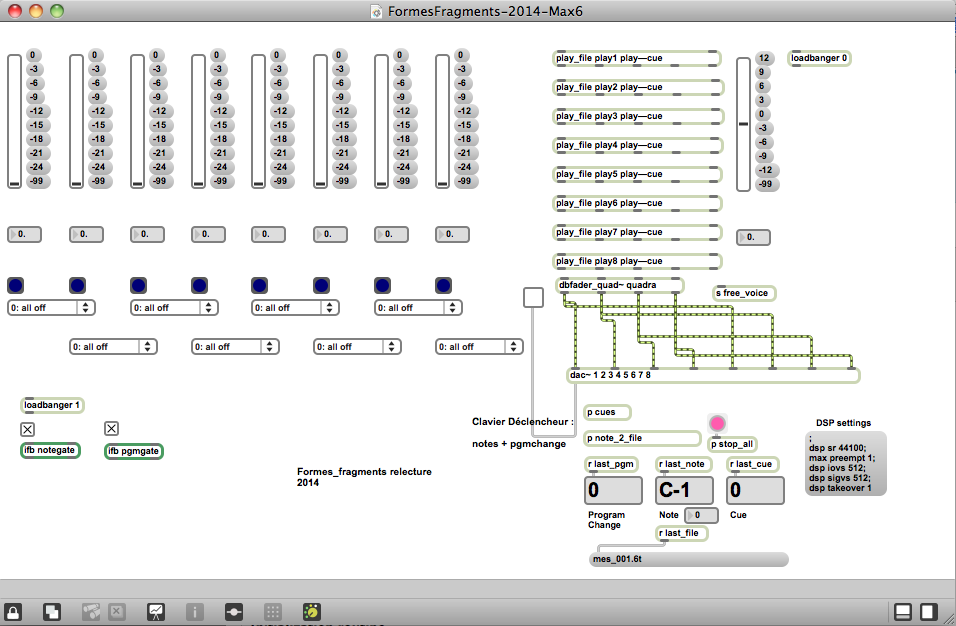Table of contents
Documentation date: 4 septembre 2014
Version state
Valid
Validation date: 3 mai 2018
Version documentalist
- muller (Augustin.Muller@ircam.fr)
Version realisation
- Gilbert Nouno (Computer Music Designer)
Upgrade Motivation
Max6 update
Other version(s)
Detailed staff
- ensemble de voix solistes à 4 voix (soprano solo [], mezzo-soprano solo [], ténor solo [], baryton solo [])
- clarinette (aussi clarinette basse), basson (aussi contrebasson), cor, trompette, trombone, tuba, percussionniste, harpe, clavier électronique/MIDI/synthétiseur, violoncelle, contrebasse
Electronic equipment list
Computer Music Equipment
-
1 MacBook Pro - Apple Laptops
(Apple)
-
1 Max 6 - Max
(Cycling74)
version 6.1.x or above -
1 Fireface 800 - Sound Board
(RME)
at least 4 audio outputs -
1 KX 88 - MIDI Keyboard
(Yamaha)
for triggering soundfiles. pgm change buttons needed
Work related information
Premiere
- 27 juin 1999, Paris, Ircam, Espace de projection
Publisher :
- Lemoine
Realisation
- Gilbert Nouno
Work length
- 15 mn
Useful links on Brahms
- Formes-Fragments IIb pour quatre voix, ensemble et électronique (1999), 15mn
- Michael Jarrell
| File | Author(s) | Comment | |
|---|---|---|---|
| Download [878,9 Mio] | All-in-one formes-fragments patch and sounds | Augustin Muller |
Instructions
Audio setup
- No input (adc)
- 4 outputs
Loudspeaker setup
- 4 loudspeakers around the audience :
Stage
1 ---------------------- 2
Audience
3 --------------------- 4
- DAC 1 : L
- DAC 2 : R
- DAC 3 : LB
- DAC 4 : RB
Midi setup
1 midi keyboard for triggering.
Software installation
Place the folder in your max file preferences
System calibration and tests
Test midi connexion and pgm changes.
PGM button 1 corresponds to PGM 1 (beware of KX88 !)
Initialization routine
Check audio and midi.
Patch presentation
The patch uses the first 1,2,3,4 outputs and also duplicates them on to 5,6,7,8 in case you need it.
You should map the 1-2-3-4 outputs as the scheme above describing the loudspeakers around the audience.
The maxmsp patch pre-loads the soundfiles.
when pre-loading is finished, turn dac on with the toggle at the left of the dac~ object.
You can adjust the main level with the fader at the upper right of the patch (default is 0 dB )
You can see the program numbers in the patch when changing program change with the keyboard (midi channel 1)
Playing a note run a soundfile if one is attached to this note (see score)
You can follow the cues number in the patch display.
The pink bang button is used to stop all the current playing sounds.
The toggle notegates desactivate the note in from keyboard (default on)
The toggle pgmgate desactivates the program change from keyboard (default on)
You can set the audio configuration by double-clicking in the dac~ object.
Top 8 faders give a visual feedback of the current levels of the files played.
To check the midinotes/sounds mapping, have a look in the "p cues" section.
Notes trig cues which combines soundfile, level and enventually pcm pgm change indications.
Cues are triggered by the keyboard with specific notes & pgm change
play_list syntax
"play_list_01" this is the play list where the soundfiles are defined to be played as the following :
program_change*1000 + midinote , the file name, the level in dB, the output type.
as example the following line "1038 , mes_003.spat 6 4;"
means the file "mes_003.spat" is trigger when we are in program 1 (*1000) and play the D1 (38) note (1000 + 38 = 1038), then the level is +6dB and the output is 4 i.e. real quadra file
the different types of output are :
0 off
1 front stereo (i.e. 1-2)
2 rear stereo (i.e. 3-4)
3 cross stereo (stereo on 1-2 and 3-4)
4 real quadra (i.e. 1-2-3-4)
- You can test sounds using the graphic keyboard in the "note 2 file" subpatcher, and also change manually the pgm change (1 to 5 are used)
© IRCAM

This documentation is licensed under a Creative Commons Attribution-NonCommercial-NoDerivatives 4.0 International License.
Version documentation creation date: 4 septembre 2014 10:49, update date: 6 mai 2021 15:09
